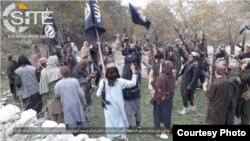One of the Islamic State terror group’s most dangerous affiliates has its sights set on the West and could launch an attack before the year is out, according to a top U.S. military official.
Despite sporadic skirmishes between Afghanistan’s ruling Taliban and Islamic State’s Afghan affiliate, known as IS-Khorasan or ISIS-K, the terror group is closer to taking its fight beyond Afghanistan’s borders, U.S. Central Command’s General Michael Kurilla told lawmakers on Thursday.
"They can do external operations against U.S. or Western interests abroad in under six months with little to no warning," Kurilla said.
The CENTCOM commander said there was a “higher probability” that IS-Khorasan operatives would target Western or U.S. interests in Asia or Europe, noting it would be “much harder” for them to carry out an attack against the U.S. homeland.
Kurilla’s assessment comes more than a year and a half after the last U.S. troops left Afghanistan, severely degrading the ability of the United States and its partners to gather intelligence on groups like IS-Khorasan or its rival, al-Qaida.
It follows similar assessments by other top U.S. officials, who see evidence IS-Khorasan is looking to make a statement on the global stage.
"It's a matter of time before they may have the ability and intent to attack the West," the chief of the Defense Intelligence Agency, Lieutenant General Scott Berrier, told lawmakers at a hearing last week.
In January, the top U.S. counterterrorism official told a virtual audience that IS-Khorasan is the "threat actor I am most concerned about.”
“We see concerning indications of ISIS-Khorasan in Afghanistan and its ambition that might go beyond that immediate territory," said National Counterterrorism Center Director Christine Abizaid, declining to elaborate on how soon the IS affiliate might try to strike.
Other countries are also seeing signs of a rising IS-Khorasan.
Intelligence shared by member states for a U.N. report last month warned IS-Khorasan has anywhere from 1,000 to 3,000 fighters who have established cells in Kabul and in Kunar, Nangarhar and Nuristan provinces.
Smaller groups of IS-Khorasan fighters are thought to have established themselves in as many as five additional provinces, and the group is actively recruiting in multiple languages, from Pashto to Persian to Russian.
The report further warned that IS-Khorasan is seeking to “undermine the relationship between the Taliban and neighboring countries … by targeting diplomatic missions."
Kurilla is not the first U.S. official to suggest that an attack by the group on a Western target could be imminent.
In October 2021, just months after the U.S. withdrawal, the No. 3 official at the Pentagon warned that IS-Khorasan was positioned to conduct external operations in as little as six to 12 months.
That dire prediction did not come to pass, and until several months ago, most U.S. officials agreed the IS Afghan affiliate had shown few indications it could strike outside the region.
U.S. military and intelligence officials have said getting a more accurate gauge on developments in Afghanistan has been difficult because of the lack of a presence on the ground and the distances American surveillance planes and drones have to cover before they can conduct surveillance.
“Our intelligence is degraded,” Kurilla told lawmakers on Thursday.
“We're working to close that gap with alternative airborne ISR [intelligence, surveillance and reconnaissance] and some of our other intelligence," he added, cautioning, “I believe we can see the broad contours of an attack, [but] sometimes we lack the granularity to see the full picture."
Syria and Iraq
There are also concerns about IS activity in Syria and Iraq.
“While ISIS is significantly degraded in Iraq and Syria, the group maintains the capability to conduct operations within the region and has the desire to strike outside of it," Kurilla told lawmakers.
A major worry is the 10,000 IS fighters being held in 26 mostly makeshift prisons across northeastern Syria.
Kurilla said CENTCOM is working with the U.S.-backed Syrian Democratic Forces to consolidate those prisons by constructing newer, more secure facilities.
Also concerning are the wives, children and other relatives of jailed or dead IS fighters, especially those at the al-Hol displaced-persons camp in northeastern Syria, which holds about 51,000 people, including more than 30,000 children.
“About 50% of the camp holds, espouses, some form of [Islamic State] ideology,” Kurilla warned. “The other half are trying to escape ISIS."






